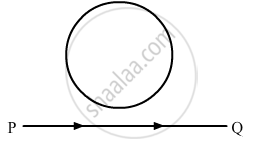Advertisements
Advertisements
प्रश्न
Deduce the expression for the magnetic field at a point on the axis of a current carrying circular loop of radius ‘R’ distant ‘x’ from the centre. Hence, write the magnetic field at the centre of a loop.
उत्तर
dB∝ `(IDlxxr)/r^3`
`dB =mu_0/(4pi) (Idlxxr)/r^3`
Here, `mu_0/(4pi)`is a constant of proportionality.
The magnitude of this field is given as
`|dB|=mu_0/(4pi) (Idlsintheta)/r^2`
Magnetic field on the axis of a circular current loop:
Consider a circular loop carrying a steady current I. The loop is placed in the y–z plane
with its centre at origin O and has a radius R.

Let x be the distance of point P from the centre of the loop where the magnetic field is to
be calculated. Consider a conducting element dl of the loop. The magnitude dB of the
magnetic field due to dl is given by the Biot–Savart’s law as
`dB=mu_0/(4pi) (I|dlxxr|)/r^3`
From the figure, we see that r2 = x2 + R2.
Any element of the loop will be perpendicular to the displacement vector from the element to the axial point. Hence, we have `|dlxxr|=rdl` Thus, we have
`dB=mu_0/(4pi) (Idl)/r^2=mu_0/(4pi) (Idl)/(x^2+R^2) ".....(1)"`
The direction of dB is perpendicular to the plane formed by dl and r. It has an xcomponent
dBx and a component perpendicular to x-axis dB⊥
The perpendicular components cancel each other when summed over. Therefore, only the x component contributes. The net contribution is obtained by integrating dBx = dB cosθ
From the figure, we see that
`costheta=R/r=R/sqrt(x^2+R^2) "...(2)"`
From equations (1) and (2), we get
`dB_x=dBcostheta=mu_0/(4pi) (Idl)/(x^2+R^2)xxR/sqrt(x^2+R^2)=(mu_0Idl)/(4pi)xxR/(x^2+R^2)^(3/2)`
The summation of dl yields circumference of the loop 2πR. Hence, the magnetic field at
point P caused by the entire loop is
`B=B_xhati=(mu_0I(2piR))/(4pi)xxR/(x^2+R^2)^(3/2)hati`
`B=(mu_0IR^2)/(2(x^2+R^2)^(3/2))hati`
Case: At the centre of the loop
At the centre x = o, so we have
`B=(mu_0IR^2)/(2(R^2)^(3/2))hati=(mu_0IR^2)/(2R^3)hati=(mu_0I)/(2R)hati`
APPEARS IN
संबंधित प्रश्न
A conducting loop is held above a current carrying wire PQ as shown in the figure. Depict the direction of the current induced in the loop when the current in the wire PQ is constantly increasing.

The net charge in a current-carrying wire is zero. Then, why does a magnetic field exert a force on it?
A straight wire carrying an electric current is placed along the axis of a uniformly charged ring. Will there be a magnetic force on the wire if the ring starts rotating about the wire? If yes, in which direction?
A charged particle is in motion having initial velocity `vecv` when it enters into a region of uniform magnetic field perpendicular to `vecv`. Because of the magnetic force the kinetic energy of the particle will ______.
An electron is moving with a speed of 3.2 × 107 m/s in a magnetic field of 6.00 × 10-4 T perpendicular to its path. What will be the radium of the path? What will be frequency and the energy in keV?
[Given: mass of electron = 9.1 × 10−31 kg, charge e = 1.6 × 10−19 C, 1 eV = 1.6 × 10−19 J]
Assertion: Free electrons always keep on moving in a conductor even then no magnetic force act on them in magnetic field unless a current is passed through it.
Reason: The average velocity of free electron is zero.
The phenomenon in which a magnetic field is produced in the space near a conductor carrying current is called ______
An electron enters with a velocity v = v0i into a cubical region (faces parallel to coordinate planes) in which there are uniform electric and magnetic fields. The orbit of the electron is found to spiral down inside the cube in plane parallel to the x-y plane. Suggest a configuration of fields E and B that can lead to it.
The unit Wbm-2 is equal to ______.
Distinguish between the forces experienced by a moving charge in a uniform electric field and in a uniform magnetic field. (Any two points)
